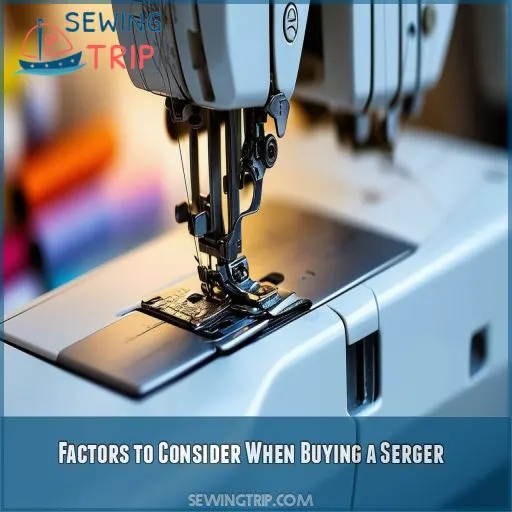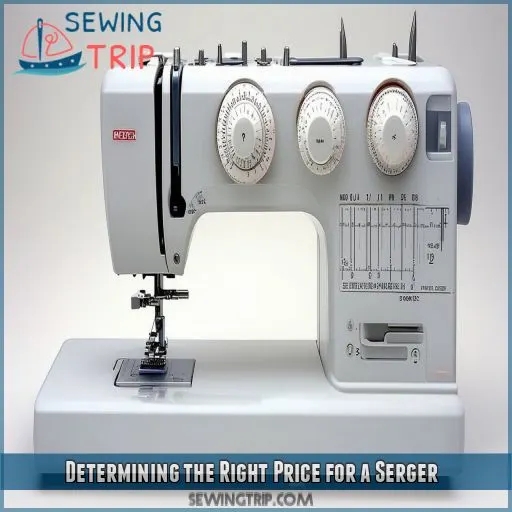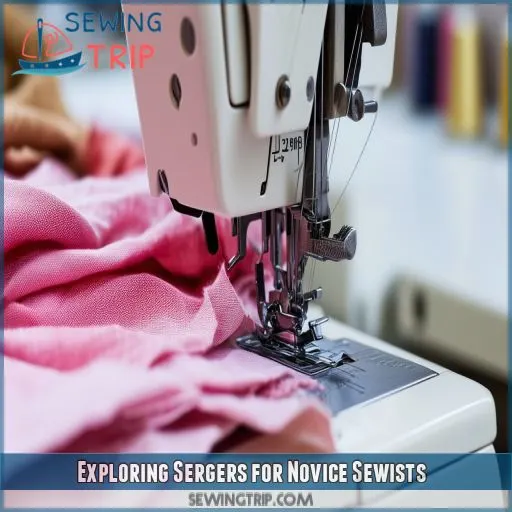This site is supported by our readers. We may earn a commission, at no cost to you, if you purchase through links.
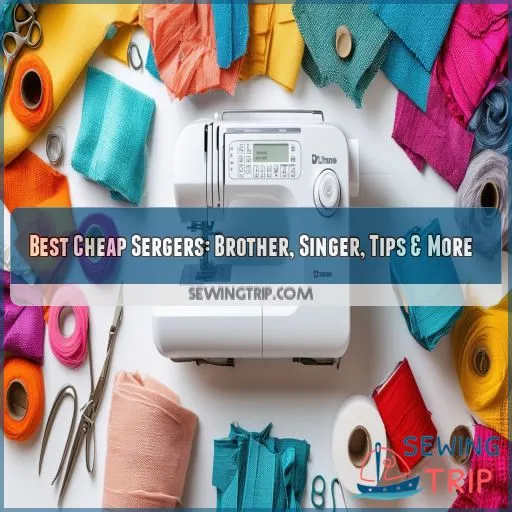
A serger, or overlocker, is a machine that cuts and neatens raw fabric edges, preventing them from fraying.
This article will reveal the best affordable sergers on the market, with a focus on Brother and Singer models. We’ll also discuss the features you should look out for, pricing factors, and why a serger is a great investment for beginners.
Improve your sewing skills and finish your projects like a pro!
Table Of Contents
Key Takeaways
Sergers, also known as overlockers, are like the Swiss Army knives in the sewing realm, offering a diverse range of functions to elevate your projects. For those new to the game, user-friendly sergers with clear instructions, easy threading, and adjustable stitch settings can be game-changers. Don’t shy away from starting with an affordable serger; they can still produce impressive results and aid in skill development. Remember, ‘a stitch in time saves nine!’ Investing in a serger now will ensure your creations look professional and withstand the test of time.
Best Cheap Sergers
When you’re searching for the best budget-friendly sergers, consider options like the Brother CS7000X Sewing Quilting Machine, Brother Coverstitch Serger 2340CV, and the Singer ProFinish 14CG754 Serger. These machines offer essential features, ease of use, and reliability that make them excellent choices for beginner and intermediate sewists alike.
1. Brother CS7000X Sewing Quilting Machine
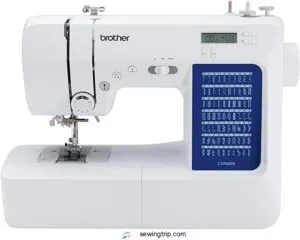
The Brother CS7000X Sewing Quilting Machine is a versatile and user-friendly option for sewists of all skill levels.
It offers 70 unique built-in stitches and seven one-step auto-size buttonholes, unlocking a wide range of creative possibilities.
The improved automatic needle threader and jam-resistant drop-in top bobbin ensure seamless sewing, while the large needle-to-arm workspace accommodates larger projects with ease.
This machine also comes with a range of accessories, including a wide table, multiple sewing feet, a quilt guide, and a protective hard case, making it a comprehensive and well-equipped choice for your sewing ventures.
Best For: Beginners and experienced sewists seeking a versatile and user-friendly machine for a wide range of sewing projects.
- Easy to use with improved automatic needle threader and jam-resistant drop-in top bobbin
- Durable metal frame construction and large needle-to-arm workspace
- Includes a wide range of accessories for various sewing needs
- Not intended for use with heavy fabrics
- May require cleaning and maintenance
- Light may not be very strong
2. Brother Coverstitch Serger 2340CV
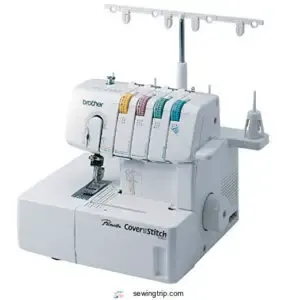
The Brother Coverstitch Serger 2340CV is a fast and efficient machine, boasting a speed of 1,100 stitches per minute.
Easy to use, it features color-coded threading and a fast thread looper system.
This serger also offers versatility with a range of stitch options, including tri-cover, wide, and narrow cover stitches.
Built to last, the machine has a metal frame and internal parts. While some reviewers had issues, others have praised its quality and reliability.
Best For: Intermediate to advanced sewers looking for a reliable and versatile cover stitch machine.
- Fast and efficient with a speed of 1,100 stitches per minute
- Easy to use with color-coded threading and a fast thread looper system
- Versatile with a range of stitch options, including tri-cover, wide, and narrow cover stitches
- Some reviewers had issues with the machine’s durability
- Machine may have a learning curve
- Machine is only intended for sale in the US at 120 volts
3. Singer ProFinish 14CG754 Serger
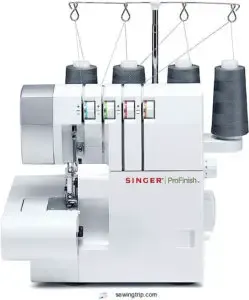
The Singer ProFinish 14CG754 Serger is a solid choice for those seeking a balance between affordability and functionality. With a 2-3-4 thread capability, adjustable stitch length and width, and a differential feed, this machine offers versatility and control over your sewing projects. Its color-coded lay-in threading simplifies the threading process, and its portable design with a built-in handle makes it convenient to carry to sewing classes or workshops.
One of its standout features is the free arm for sewing sleeves and cuffs, ensuring ease of use when working on cylindrical items. The 14CG754 also boasts an impressive stitching speed of up to 1,300 stitches per minute, allowing you to efficiently power through your projects. Additionally, automatic fabric trimming streamlines your sewing experience by cutting and finishing edges in one smooth step.
While this serger may not be as high-end as some top-of-the-line models, it’s backed by a 25-year limited warranty for the sewing machine head, providing peace of mind and confidence in your investment. With its combination of features, performance, and durability, the Singer ProFinish 14CG754 Serger is a strong contender in the realm of affordable sergers.
Best For: Those seeking a balance between affordability and functionality in a serger
- Adjustable stitch length and width for versatility and control
- Free arm for easy sewing of sleeves and cuffs
- Impressive stitching speed of up to 1,300 stitches per minute
- Not as high quality as top-of-the-line sergers
- Telescoping thread tree/guide may get loose over time
- May need to adjust tension when using different threads or fabrics
Factors to Consider When Buying a Serger
When choosing a serger, consider how easy it’s to thread, especially with options like color-coded threading for clarity. Also, pay attention to the differential feed, which adjusts the fabric feed to produce seamless and polished seams.
Threading Ease
When considering a serger, threading ease is a significant factor. You want a machine that simplifies the threading process, saving you time and frustration. Look for features like color-coded threading, automatic threading, or guided threading with tension dials and threading charts.
The Brother 1034D, for example, offers color-coded threading illustrations, making it a breeze to thread. Snap-on feet and video tutorials or color-coded illustrations can also make threading a cinch.
Differential Feed
When buying a serger, the differential feed is a key feature to contemplate. This mechanism controls the movement of the top and bottom layers of fabric, allowing you to create smooth, pucker-free seams on a variety of fabric types. It’s an essential feature for handling knit fabrics and creating durable seams. The differential feed can also help you achieve the perfect seam allowance, assuring your projects look polished and professional.
Sergers with adjustable presser foot height, like the Brother 1034D, give you even more control over your fabric as you sew. This feature, combined with the differential feed, assures your fabric feeds smoothly and evenly, resulting in high-quality stitches and precise seams.
Necessity of a Serger for Beginners
If you’re new to sewing, you might wonder if a serger is necessary for your beginner projects. Sergers, also known as overlock machines, offer several benefits that can enhance your sewing experience:
- Edge Finishing: Sergers are masters of edge finishing, allowing you to cut and finish fabric edges in one smooth step.
- Fabric Durability: The tight overlock stitches created by sergers add durability to your fabric, ensuring your creations last longer.
- Stitch Variety: With a serger, you access a range of stitch options, from decorative edges to ravel-free seams, giving your projects a professional touch.
- Time-Saving: Sergers work faster than traditional sewing machines, allowing you to complete projects more quickly and efficiently.
While sergers offer these advantages, they aren’t essential for beginners. You can create beautiful projects with a standard sewing machine and explore the realm of serging as your skills and interests develop. Ultimately, the decision to invest in a serger depends on your specific needs and the types of projects you plan to tackle.
Determining the Right Price for a Serger
When determining the appropriate price for a serger, you’ll need to balance affordability with value for money to guarantee you’re making a wise investment in the long run. By considering features like stitching capabilities and ease of use, you can find a serger that meets your needs without exceeding your budget.
Affordability
In terms of affordability, it’s important to find the ideal balance between cost-effectiveness and functionality. Here’s a quick overview of what to keep in mind when determining the appropriate price for a serger:
| Price Considerations | ||
|---|---|---|
| Budget-Friendly | Entry-level machines offer a balance between affordability and essential features. | |
| Cost-Effective | Look for machines that provide long-term value with consistent performance and minimal maintenance costs. | |
| Affordable Options | Brother and Singer offer a range of sergers catering to different budgets without compromising on quality. |
Value for Money
When evaluating the worth of a serger, it’s crucial to recall that they offer more than basic stitching. Sergers, or overlockers, give ravel-free seams, tight overlock stitches, and decorative edges to enhance projects.
Here are three factors to mull over when assessing serger value:
- The time and effort saved by quickly finishing edges and creating durable seams, especially with knits.
- The professional-looking results elevate projects.
- The versatility of sergers, with stitch styles and features like differential fabric feed and snap-on feet, adapts to different fabrics and projects.
Long-Term Investment
When investing in a serger, consider its longevity and durability.
Sergers with pure lighting and an adjustable presser foot height offer better visibility and fabric control, resulting in professional-looking hems and seams.
Singer’s 14J250 Stylist II Serger is a durable option; it offers adjustable stitch settings and a stitch speed of 1300 spm.
Regular maintenance, including keeping the machine clean and lubricated, ensures long-term performance and protects your investment.
Exploring Sergers for Novice Sewists
When you’re new to serging, look for models with beginner-friendly features that simplify operations and minimize the learning curve. Machines with easy threading, adjustable stitch settings, and clear instructions can help you get professional results without overwhelming you.
Beginner-Friendly Features
As a novice sewist, you’ll want to seek sergers with features that simplify the sewing process and offer flexibility for various projects. Here are three key beginner-friendly features to think about:
- Thread Tension Control: The ability to adjust thread tension is important for achieving neat, even stitches. Look for a serger with easy-to-use tension dials or knobs that allow you to fine-tune the tension for each thread individually.
- Presser Foot Options: A serger with a variety of presser foot options will give you more versatility in your projects. Look for a model that includes standard, narrow, and rolled hem presser feet to accommodate different types of seams and fabrics.
- Stitch Length and Width Adjustment: Being able to adjust the stitch length and width is essential for creating strong, secure seams. Look for a serger that offers a good range of adjustment to work with various fabric types and create different stitch effects.
Simple Operations
The best sergers for beginners offer simple operations with easy threading, intuitive buttons, and clear instructions. You want basic functions and simple dials that are easy to understand and adjust. Look for machines with color-coded threading guides and adjustable settings that are straightforward to use.
Learning Curve
Sergers can be a bit tricky to master, but with the right learning resources and practice techniques, you’ll be a pro in no time. While these machines are known for their speed, taking the time to build your skills is key. Avoid the temptation to rush and you’ll soon be handling a variety of fabrics with ease, creating professional-looking results.
Frequently Asked Questions (FAQs)
What is a good basic serger?
Sewing machines are your toolbox, and sergers are the jack-of-all-trades. For a basic serger, the Janome MOD-8933 is compact, user-friendly, and perfect for beginners. It’s a reliable workhorse for denim, knit, and hemmed projects.
How much should I pay for a serger?
Sergers can cost anywhere from $200 to $8000, depending on features and quality. Basic machines start at $200, while high-end machines can cost several thousand dollars.
Should a beginner buy a serger?
A stitch in time saves nine."
As a beginner, you can definitely benefit from buying a serger. Sergers are versatile tools that can help you create professional-looking seams, hems, and edges, enhancing the overall appearance of your sewing projects. They’re especially useful for working with knits and creating durable, ravel-free seams.
What is the difference between overlock and serger?
Sergers and overlockers are the same machine. The term "serger" is more commonly used in the US, while "overlocker" is used in the UK and Australia. Sergers/overlockers knit fabric together using an overlock stitch, which binds seams to prevent the fabric from unravelling.
What different types of sergers are available?
There are various serger types, including 2/3/4 thread sergers and 5-4-3-2 thread sergers. They offer different features like differential feed, stitch styles, and speed. Sergers are ideal for creating professional finishes and handling various fabrics.
How do sergers differ from traditional sewing machines?
Sergers differ from traditional sewing machines in several ways. Sergers cut and sew fabric, using 3-4 threads to create an overlock stitch. They’re faster, have shorter necks, and can only sew on the left side of the needles.
Are sergers suitable for all fabric types?
Sergers work with many fabric types, especially knits and denim. They’re also suitable for heavy and thick fabrics like leather. Sewing machines, however, offer more versatility for various fabric types.
What key benefits do sergers offer?
Sergers are a great investment if you want to sew clothing that looks professionally made. They keep seams from unraveling, trim seam allowances, and finish raw edges to prevent fraying. Sergers are also ideal for sewing knits and stretchy fabrics, creating durable stitches that survive countless washes.
How does a serger create a professional finish?
Sergers create professional finishes with clean, durable seams and edges that don’t unravel. They work at high speeds, trim raw edges, and finish edges in one pass. For a smooth, no-bulk seam, try flatlocking. Serging stretchy and knit fabrics can also help prevent wavy seams.
Conclusion
Serging Ahead
Now you know about some of the best cheap sergers on the market, along with the key considerations when buying one. Remember, sergers offer a great way to finish your sewing projects with a professional touch. Whether you’re a beginner or a seasoned sewist, investing in one of these machines can elevate your creations to the next level. So, go ahead and explore the realm of serging, taking your pick from the affordable options outlined above!

